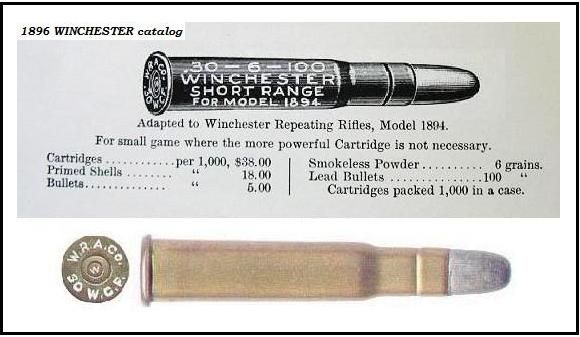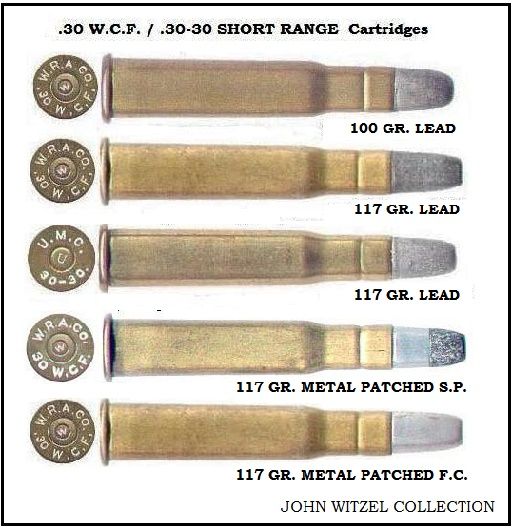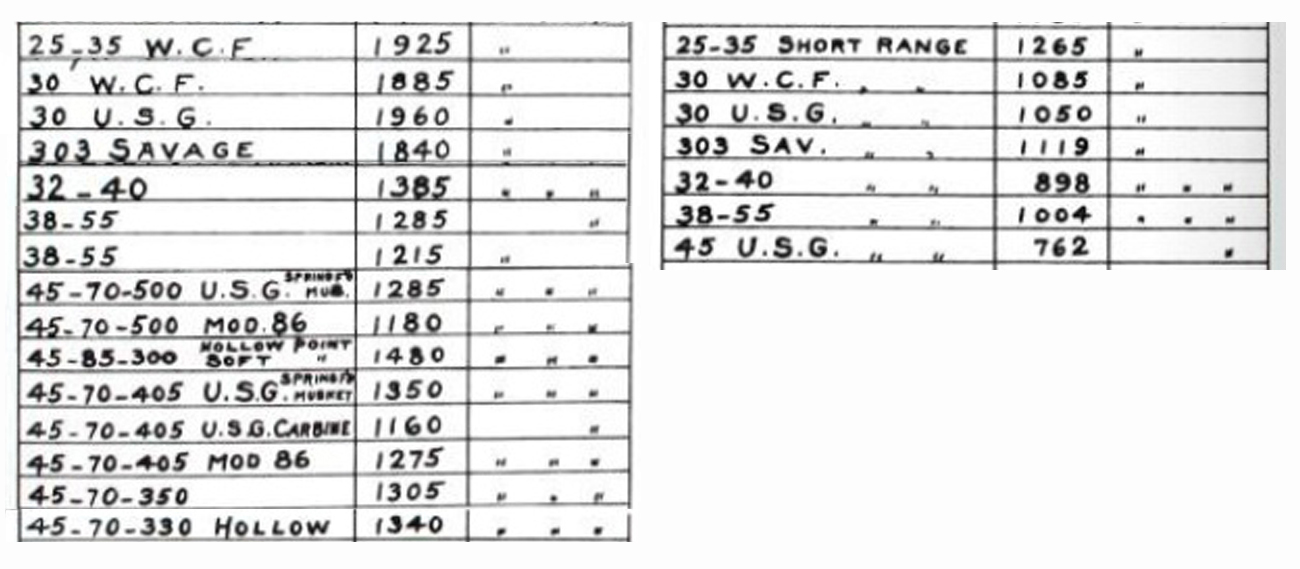April 14, 2011
 Offline
OfflineIn December of 1896, Winchester began offering special .30 W.C.F. “Short Range” ammunition to be used for “small game where the more powerful cartridge is not necessary” as it was described in that catalog. The cartridge illustration was shown as the .30-6-100 since cartridges contained a 100 gr. lead bullet and 6 grains of powder. A few months later, U.M.C. followed suit with their .30-30 Marlin “Short Range” cartridge.
Winchester recognized the benefit and increased versatility that a factory loading for small game would offer, since the average family would have to sacrifice at least a month’s pay to buy just one rifle, and that one rifle was just about all that most families could afford. With his or her magazine full of these .30 W.C.F. “Short Range” rounds, hunters could use their big game rifles to harvest turkeys, squirrels and other small game animals with no meat loss. Then, if bigger game was expected to be encountered, a change to the standard .30 W.C.F. cartridge would handle that situation.
In 1904, Winchester increased the lead bullet weight from 100 to 117 grs. and the following year, they also offered a 117 gr. soft point and a 117 gr. full metal patch version.
These “Short Range” cartridges were loaded to the same o.a.l. as the standard cartridges and are easily identified as having a cannelure part way down the case neck. It was used to keep the soft lead bullet from being pushed into the case under spring pressure while in the magazine and it was not needed with the metal patched bullets, but was retained to distinguish them from the full power .30 W.C.F. & .30-30 cartridges which looked similar.
Winchester .30 W.C.F. “Short Range” ammunition was cataloged until the early 1920’s when it was taken out of production due to the decreasing demands for it as many families had acquired additional firearms specifically for small game.
Velocities were never listed in any of the catalogs, but, thankfully, I was able to obtain some original lead bulleted cartridges, extract the powder and bullets and reload the components into modern brass. Velocities ranged between 1,120 to 1,200 f.p.s. depending on bullet weight.
In an effort to duplicate this historical ammunition, I tested numerous current powders and found that with a 100 gr. cast bullet, 4.7 grains of either Winchester’s 231 or Hodgdon’s HP38 worked well as did 5 grs. of Unique or 4756. With a 115 gr cast bullet (Lyman 311008) 5.5 grs. of 231 or HP38 or 6 grs of either 4756, Unique or Hodgdon Universal matched the weight of the original powder charge and produced similar velocities. No fillers of any kind were used and accuracy was excellent, giving groups of 3/4″ to 1 1/4″ at 50 yards and 1 1/2″ – 2 1/2″ groups at 100 yards if I did my part.
These cartridges work the same way in the game fields today, as they did 100+ years ago. So, if you want to step back in time, go woods wandering with your favorite .30 W.C.F. /.30-30 lever gun in small game season with it’s magazine filled with replications of this historic ammunition (If legal in your state.). In addition, they would have been and are great for target practice and plinking.
In that bygone era when mother nature provided some of the meat supply, the soft spoken report of the .30 W.C.F. “Short Range” cartridge meant additional sustenance for many families.
——————
Update:
I eventually decided that I would like a bullet that replicated the original 117 gr. S.R. bullet, so I measured one of the original 117 gr. bullets I pulled from a .30 W.C.F. Short Range cartridge and sent the dimensions to http://www.accuratemolds.com .
It is now in their catalog as the 31-115K and weighs from 117 to 122 grs. depending on the alloy used.

I have been very pleased with the results.
w30wcf
December 30, 2011
 Offline
OfflineVery good post. I enjoyed reading about the Short Range ammunition. 28gauge got his question answered from a few weeks ago too.
Brad
May 23, 2009
 Offline
Offline

I too have looked for the Velocities of the Short Range Cartridges. All I have found was this reference from the 1999 Spring WACA Collector Magazine towards the back. I went ahead and combined the two charts to make it easier to read.
Hope this helps in regards to Original Factory Velocities regarding Short Range cartridges.
Sincerely,
Maverick
![]()
WACA #8783 - Checkout my Reloading Tool Survey!
https://winchestercollector.org/forum/winchester-research-surveys/winchester-reloading-tool-survey/
April 14, 2011
 Offline
Offline28 gauge, Hedley Lamarr, Thank you for the kind words.
Maverick, Thank you for the look back into the past. The 1,085 f.p.s. shown was taken at least 25 ft from the muzzle, making the muzzle velocity a bit over 1,100 f.p.s.
Dissecting the 30 or so various “Short Range” cartridges I was able to acquire, most revealed powder charges from 4.7 – 6 grs in the S.R. cartridges containing 100 gr bullets and 5.5 – 7 grs. smokeless under the 117 gr version.
I did find several 100 gr. S.R. that contained 8 grs of powder that produced a faster than normal 1,308 f.p.s.
Winchester used several different powders with different burning rates – faster powders with the lighter charge weights and slower ones with the heavier charges. They were also of both the “dense” and “bulk” type.
In affect, .30 W.C.F. “Short Range” ammunition was the ballistic equivalent to the excellent .32 W.C.F. / .32-20 cartridges.
w30wcf
May 23, 2009
 Offline
Offlinew30wcf said
28 gauge, Hedley Lamarr, Thank you for the kind words.
Maverick, Thank you for the look back into the past. The 1,085 f.p.s. shown was taken at least 25 ft from the muzzle, making the muzzle velocity a bit over 1,100 f.p.s.
Dissecting the 30 or so various “Short Range” cartridges I was able to acquire, most revealed powder charges from 4.7 – 6 grs in the S.R. cartridges containing 100 gr bullets and 5.5 – 7 grs. smokeless under the 117 gr version.
I did find several 100 gr. S.R. that contained 8 grs of powder that produced a faster than normal 1,308 f.p.s.
Winchester used several different powders with different burning rates – faster powders with the lighter charge weights and slower ones with the heavier charges. They were also of both the “dense” and “bulk” type.
In affect, .30 W.C.F. “Short Range” ammunition was the ballistic equivalent to the excellent .32 W.C.F. / .32-20 cartridges.
w30wcf
w30wcf,
I’m not surprised at all your numbers are slightly different from the Winchester Factory data. Who’s to say which data is more accurate? I certainly no expert when it comes to chronographs and chronoscopes. I find it interesting the factory data notes the distance between the screens as being 15, 50 & 100ft. Much longer distances than the modern sky screens of today. I also wonder if the age of the powder in the cartridges you tested would come into to play, if at all, in regards to your results compared with factory data. Then again there are other variables to contend with. We don’t know what time of day or the temperature ranges the factory was contending with when producing there data. But rest assure I imagine a modern chronoscope is more accurate in measuring velocity than what the factory had in the 1896-1920 time frame. But I still ponder how accurate there machine was. It amazes me just how precise Winchester was when producing there products.
Sincerely,
Maverick
![]()
WACA #8783 - Checkout my Reloading Tool Survey!
https://winchestercollector.org/forum/winchester-research-surveys/winchester-reloading-tool-survey/
April 14, 2011
 Offline
OfflineMaverick,
There are certainly variables to be sure. Different powders used, different lots, different charge weights and so on. My goal at the time (15 years ago or so) was to determine what velocity range the Short Range cartridges were loaded to. In testing I found that, for the most part, they fell into the 1,100-1,200 f.p.s. range which pretty much matches the information that you posted (Thank you!) .
I think that the distance between screens at that time were established in accordance the equipment’s ability to measure time. Today time can be measured in millionths of a second, back then, not quite that fast. Note that the velocities of the higher velocity cartridges were measured at 50 ft (100 ft between screens) whereas they used a shorter distance for the lower velocity cartridges.
I do feel that the method Winchester used was pretty accurate. I once tested some original W.R.A. CO. .30 W.C.F. head stamped cartridges. I did need to replace the primers that were of the mercuric type and had long since died. Catalog velocity was 1,970 f.p.s. and the average velocity recorded with the “Shooting Chrony” I was using, was very close to that number.
If smokeless powders have deteriorated, they produce an acrid smell. With one exception, the different powders taken from the W.R.A. CO. .30 W.C.F. Short Range cartridges that I tested did not show signs of deterioration and based on the data you presented, they had not lost any ballistic strength over the years.
w30wcf


 Log In
Log In










